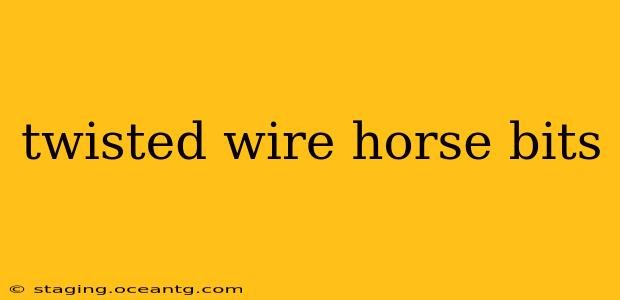Twisted wire horse bits are a type of bit known for their unique design and the way they apply pressure to a horse's mouth. While they can be effective in certain situations, understanding their mechanics and potential impact is crucial for responsible horsemanship. This guide will delve into the specifics of twisted wire bits, exploring their various types, how they work, and considerations for their appropriate use.
What are Twisted Wire Horse Bits?
Twisted wire horse bits are characterized by their construction: a mouthpiece made of twisted wire, often with a relatively thin diameter. This design creates a series of points or "knots" along the mouthpiece. The twisting action increases the surface area contacting the horse's mouth, leading to a potentially more intense response compared to smoother bits. They come in various shapes and sizes, influencing the location and intensity of pressure.
How do Twisted Wire Horse Bits Work?
The pressure exerted by a twisted wire bit is multifaceted. The knots and twists create multiple points of contact, impacting the horse's tongue, bars, and lips. The severity of the pressure depends on several factors: the thickness of the wire, the degree of twist, the horse's sensitivity, and the rider's hand. A strong, heavy hand can amplify the pressure considerably, potentially causing discomfort or even pain.
What are the Different Types of Twisted Wire Horse Bits?
Twisted wire bits are available in various designs, each affecting the way pressure is distributed within the horse's mouth:
- Loose Ring Twisted Wire Bits: These offer some lateral movement, allowing the bit to rotate slightly in the horse's mouth. This can be gentler than fixed-ring designs.
- Full Cheek Twisted Wire Bits: The cheek pieces extend further, preventing the bit from rotating too much. This is often preferred for horses that tend to evade bit pressure.
- D-Ring Twisted Wire Bits: Similar to loose rings, but with a D-shaped ring, they provide a balance between maneuverability and stability.
The choice of bit depends on the horse's temperament, training level, and the rider's experience.
Are Twisted Wire Horse Bits Cruel?
The ethical implications of using twisted wire bits are often debated. While the design can inflict significant pain if used improperly or with a heavy hand, they are not inherently cruel. The key is responsible usage. A properly fitted bit used by an experienced rider with a soft, consistent hand can be effective. However, many prefer gentler bit options, considering twisted wire potentially harsh for sensitive mouths.
When are Twisted Wire Horse Bits Appropriate?
Twisted wire bits might be considered in specific training scenarios where a stronger, more direct communication is deemed necessary. However, it’s crucial to understand this is a last resort. Before resorting to a twisted wire bit, explore gentler bit options first. If a twisted wire bit is used, it's paramount to ensure the horse is properly trained and the rider has the necessary skill to utilize it without causing pain.
What are the Alternatives to Twisted Wire Horse Bits?
Numerous alternatives offer similar levels of control with potentially less harshness:
- Snaffle bits: These are simpler bits that apply direct pressure to the bars and tongue.
- Loose ring bits: These allow for more flexibility in the horse's mouth.
- Mullen mouth bits: These offer a solid, even pressure.
The appropriate bit choice is highly individualized and depends on the horse and rider. Consulting an experienced equine professional is always recommended.
What are the Potential Problems Associated with Twisted Wire Horse Bits?
Improper use of twisted wire bits can lead to several issues:
- Mouth sores and injuries: Excessive pressure from improperly used bits can cause significant discomfort and injury.
- Resistance and behavioral problems: Pain and discomfort can make a horse resistant to the bit, leading to behavioral problems.
- Damage to the horse’s teeth: The sharp edges of some twisted wire bits can damage a horse's teeth over time.
How Can I Choose the Right Twisted Wire Horse Bit?
Choosing the right bit requires careful consideration. Factors to consider include:
- Horse's mouth conformation: The shape and size of the horse's mouth will influence bit selection.
- Horse's temperament and training level: A sensitive horse might need a gentler bit than a more experienced horse.
- Rider's experience and skill: An inexperienced rider might not be able to use a twisted wire bit effectively.
Consult with an equine professional for guidance on selecting the appropriate bit for your horse. Remember, the goal is clear communication and partnership, not forceful control.
This guide provides general information and should not replace professional advice. Always consult with a qualified equine professional for personalized guidance on bit selection and training.
